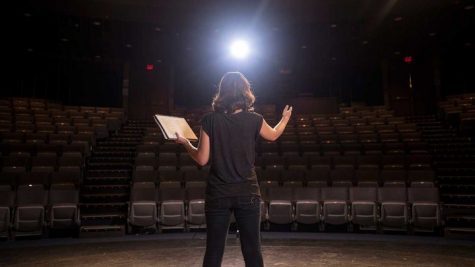‘West of the Imagination’ comes to Calvin Center Art Gallery
The newest on-campus art exhibition, West of the Imagination, presenting pieces by professor Franklin D. Speyers, is showing at the Center Art Gallery until Dec. 20. The paintings have also been featured in the “Cowboys and Indians” August issue.
Last Saturday, Oct. 28, the gallery had an opening reception attended by over 200 visitors. At the event, there were several posters of the paintings available for sale as well as copies of the “Cowboys and Indians” issue. The exhibition has 30 painted pieces and several accompanying drawings, focusing on contemporary native Americans, cowboys and landscapes of the West.
The exhibition, as the wall-text explains, is “[…] celebrating the beauty of the West and questioning the romanticized representations of western life” and counts several landscape and portrait paintings. Speyers’ pieces are characterized by striking compositions where the subject, an indian or a cowboy, is cropped, their gaze cut off by the edge of the canvas.
“Composition is where you see the strongest influence of my graphic design background,” said Speyers in his interview to “Cowboys and Indians.” “Playing with framal reference is where I prefer to create tension, placing my subjects heading off screen.”
Landscapes are usually depicted as wide-open spaces where the characters seem small against the “cinematic” world.
“For me, I love the exhibition because it is a nice reminder of home […] the great big skies with horses remind me of my roots,” said Rebekah Inman, a senior.
Speyers has adopted a characteristic style of painting through plein air and incorporates an undercoat in orange for all of his paintings. Under the layers of oil, the orange contrasts with the blues and whites, adding interest and a unique taste to Speyers’ paintings. Some paintings, like “The Lasso” (40”x72”), lets the orange transpire through, incorporating it within the sky, while others, like “Giddyap” (42”x56”), conceals the orange under layers of oil.
“Van Ruisdael continues to inform the dominant visual syntax for my landscape paintings,” Speyers told “Cowboys and Indians.”
Speyers’ interest in the West started in his childhood when he would watch Gene Autry while immigrating to Canada, from the Netherlands, and only later to the U.S. He said on an interview for Calvin’s website, “I couldn’t understand a word of English, but as a stranger in a strange land, yet I was drawn into an enigmatic kinship with a genre that dramatized the triumph of the self-reliant lone hero overcoming conflict.”
As Speyers grew up and eventually made many excursions to the west, he realized how limited his understanding of the West had been.
“From movies, I was conditioned to accept the stereotypical images of Sioux, Cheyenne, and Navajo as warlike people. In person, I found them to be gracious and gentle, eager to dialogue and be understood,” he said to “Cowboys and Indians.” “[…] They have good reason to remain wary even to this day — in peaceful protest. They find little support for their perspectives and values. They’ve accommodated, straddled and adapted to the conquistador for more than 500 years. And they survived.”






